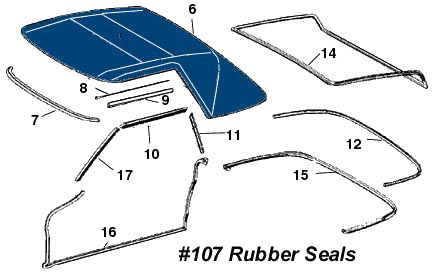How to Install a Mercedes Convertible Soft Car Top
TOOL/MATERIALS REQUIRED
Phillips & Slotted Screwdriver --Scissors --Marking pencil or Chalk --Metric
socket set.
Blunt stuffing tool(rounded putty knife)--Awl
Spray Adhesive 1 can. or Brush Adhesive, quart
Pulling wire
Weatherseal Adh. black #9412--Silicone Adh. Black #9413
Protective blankets --Masking tape
Pliers or Vice Grips--Hooked tool
ADDITIONAL PARTS THAT MAYBE REQUIRED
Top Straps, pr. #107-3056 (not illustrated)
#7=Top to windshield weatherseal #107-2196,
#10=Door glass to top frame weatherseal, horizontal #107-2199, 2 req.
#11=Door glass to top frame weatherseal, verticle #107-2200, 2 req.
#17=A post weatherseal #107-2291/2202, 2 req.
#12=Top to rear deck lid weatherseal #107-2198,
#8=Side cables (pr) 107-2195,
#9=horizontal side seal is included with all STF or German canvas tops
Call for pricing.

Preparation